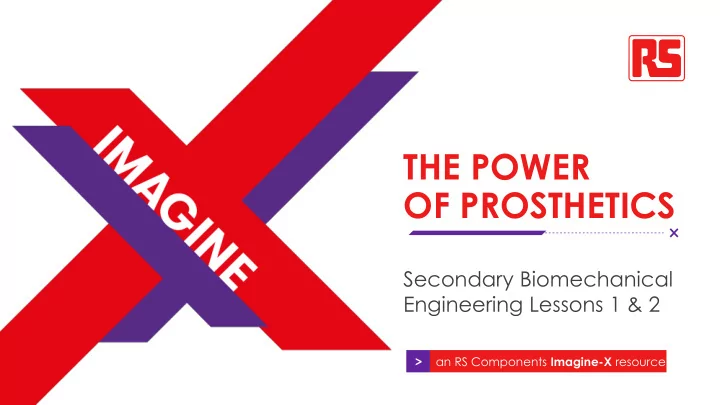

THE POWER OF PROSTHETICS Secondary Biomechanical Engineering Lessons 1 & 2 > an RS Components Imagine-X resource
[Play intro video for biomechanical engineering – secondary]
A prosthetic is… – An artificial or ‘fake’ body part – Used in place of a missing biological or ‘real’ body part – Sometimes can be used to fill the function of a missing, or damaged body part
Prosthetics Non-functional can be… Just for the ‘look’ Body-powered Made functional by another part of the body (through levers and pulleys etc.) Brain-powered Powered by electrical signals from the brain – like a real limb would be
Instead of skin, muscles, and bones… BONES Lightweight metal such as titanium or aluminium alloy LIGAMENTS AND MUSCLES Plastics such as polyurethane and carbon fibre SKIN Foam or material
> Quality of life… “ The standard of health, comfort and happiness experienced by an individual or group …what would happen ” to your quality of life if you needed a prosthetic, but didn’t have one?
Why are prosthetics important? - Better conduct of day-to-day activities (eating, gaming, dressing etc.) - Help people lead ‘normal’ lives - Good for self confidence and body image - Increase mobility (moving around without help)
Each part of our musculoskeletal system does something for us – For support (keeps our bodies together) – For protection (keeps our organs safe) – For movement (makes our bodies move)
What do our musculoskeletal components do… > Muscle Movement > Tendons and ligaments Supportive, movement > Bones Protective, supportive, movement > Skin Protective, supportive
Distal Middle > Phalanges Proximal > Carpal Bones Trapezoid Trapezium > Metacarpal Bones Capitate Scaphoid Hamate Triquetrum > Carpal Bones Pisiform Lunate
https://www.youtube.com/watch?v=FVIpeUIpFf0
- Which human parts are missing/need replacing - The specifications How would (measurements) of the person you design a receiving the prosthetic - Which parts need to move, prosthetic limb? and which need to be ‘fixed’ - The functions they need to perform > Think about… - The specifications of the healthy/non-missing limbs
Every limb is different… Prosthetics can’t be ‘mass produced’ each one needs to be made specifically for the person receiving it.
How can you solve these problems? What problems – Finding cost-effective materials and does this cause? techniques – Efficient processes – Getting the first – Expensive measurements correct – Long waiting periods – Improving the design before it’s built – No room for error
> Five phases of the design thinking process Empathise Define Ideate Prototype Test
> Isometric drawing
Can you draw an isometric…? > Cube > Stairs > Sphere > Misc.
Waiting for a prosthetic Your day-to-day life (eating, travelling, dressing, washing etc.) Your education What impact would needing but not having a prosthetic limb have on your life? > Think about… Your career Your social life
In the Third World In some countries, the waiting list for getting a prosthetic is very long. – Your day-to-day life > How big an impact on… (eating, travelling, dressing, washing etc.) – Your education – Your career – Your social life > If you had to wait: – 1 year – 5 years – 15 years
What can you do, when designing a prosthetic limb, to reduce the waiting list? – Reduce the cost of Reducing the materials – Improve the process of measuring, testing the wait… and building (being more efficient) – Develop faster and less wasteful methods of building
Look at your arm and hand as you… – Pick things up – Put things down – Wave to each other – Shake hands with each other – Write with a pen > What can you see?
Find out… – How many joints are there in your arm and hand? – What type of joints are they? – What ‘function’ do they help the limb perform?
A ‘joint’ is… – A structure in the body – They are where the pieces of your skeleton fit together – 80% of them can move – They support movement
One of the members of Your your group has lost an arm! You have to design task a prototype prosthetic limb, complete with: > Skin > Muscles > Ligaments & tendons > Bones & joints … which works just like a normal arm
Prototype prosthetic cheat sheet > Muscles 1. Pick an arm from someone in your team > Ligaments & tendons 2. Measure: > Bones & joints – the ‘healthy’ limb (the new one will have to be as close to that as possible) – the ‘stump’ of the ‘missing’ limb 3. Design a new arm based on those measurements, featuring – Skin – Muscles > Skin – Ligaments and tendons – Bones with joints
Instead of skin, muscles, and bones… BONES Lightweight metal such as titanium or aluminium alloy LIGAMENTS AND MUSCLES Plastics such as polyurethane and carbon fibre SKIN Foam or material
https://www.youtube.com/watch?time_continue=3&v=Vx0Z6LplaMU
3D printing… prosthetics! - Prosthetics can be made to exact specifications - The materials are cheap - It is easier to test/prototype – with more room for error
Let’s talk… Enhancements There are several ways prosthetic limbs can be upgraded to enhance the body’s function. How would you ‘enhance’ your prosthetic arm?
– Why prosthetics are important? – What would happen if you didn’t have Thoughts to access to them? takeaway… – How can the waiting list for prosthetics be reduced? – How can your biomechanical skills be used to help people?
> ‘Biomechanics’ is… “ ... the science behind the movement of a living body, including how muscles, bones, tendons, and ligaments work together to produce movement. ”
uk.rs-online.com/stem > an RS Components Imagine-X resource
Recommend
More recommend